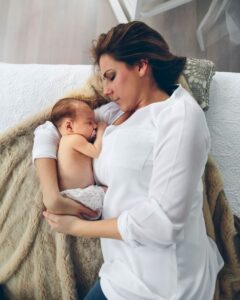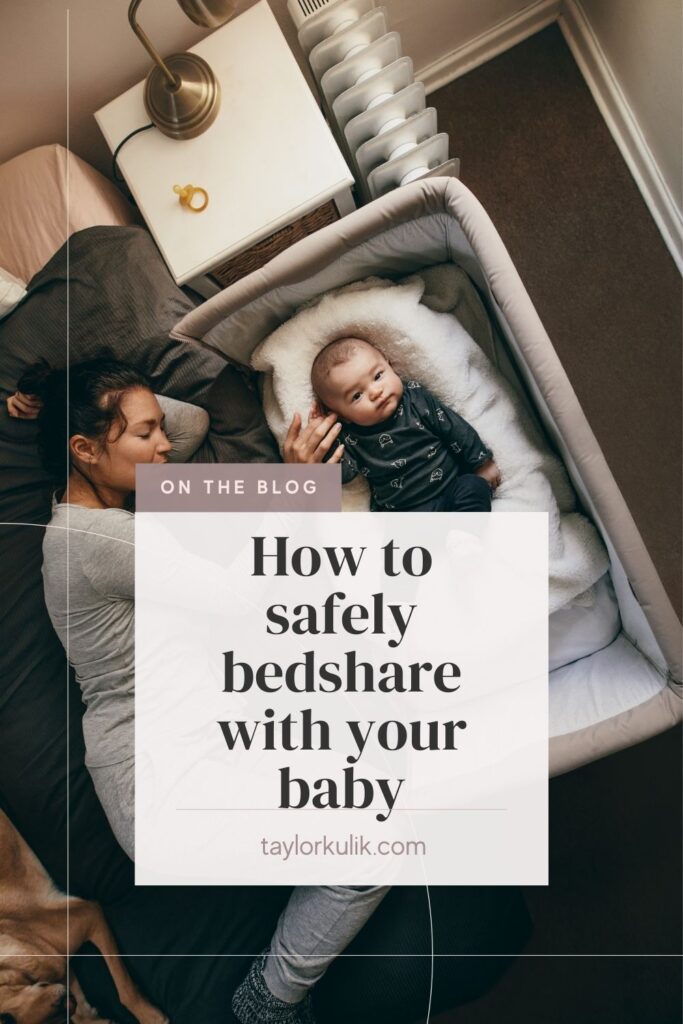So, you’ve been told that bedsharing is inherently dangerous, and you just shouldn’t do it, ever.
I have news for you: this isn’t actually what the data and research we have on bedsharing tells us. Reviewing the bedsharing research is a blog post for another day, but what I will tell you is that there is no significant risk to bedsharing for infants over three months old when there are no safety hazards present. Many researchers disagree on whether there is any risk present to safely bedsharing with an infant under three months old, so that’s still up for debate.
It’s also just not as simple as anti-bedsharing advocates would like for us to believe. You see, babies don’t care about what research says, and baby sleep location isn’t an isolated factor that exists in a box apart from other factors, like feeding, relationship, attachment, emotional security, and health. Some parents choose to bedshare because they know of the immense benefits (again- a blog post for another day, but you can listen to this podcast episode to learn about some of those benefits), and some become parents safely bedshare because it’s the only way they can get sleep. Either choice is fine! If you want to learn more about how babies sleep in the first year of life, make sure you grab this free download!

I encourage all parents to be informed about safe bedsharing, even if they don’t intend to bedshare, because sometimes parents find that they need to bedshare. Reactively bedsharing in the middle of the night, when everyone is exhausted, is often unsafe bedsharing. Having a plan and safe sleep set-up for “just in case” is much safer than reactively and chaotically bedsharing. Plus, research tells us that anywhere from 60-75% of breastfeeding mothers will bedshare at some point, even if it’s not for the entire night, so it’s helpful to be prepared in case bedsharing becomes necessary or helpful.
So how do you safely bedshare? Let’s discuss the main safety criteria for the safest bedsharing circumstances. As a note, I would never tell parents that they absolutely cannot bedshare if a safety criteria isn’t met because I understand firsthand that sometimes bedsharing is literally the only way. My goal here is to provide you with evidence-based recommendations and guidelines for the safest bedsharing scenario, and it is up to you to know your own unique circumstances and assess what the safest sleep scenario is for your child.
The Safe Sleep Seven
La Leche League has a brief overview of the major safety guidelines for bedsharing in the “Safe Sleep 7”. It goes like this:
If you are:
- A nonsmoker
- Sober and unimpaired
- A breastfeeding mother and your baby is:
- Healthy and full-term
- On his back
- Lightly dressed, and you both are
- On a safe surface
Then your baby in bed with you is at no greater risk for SIDS than if he’s nearby in a crib.2
The Safe Sleep 7 is a great overview of bedsharing guidelines, but there are some more specific details that families need to know before they bedshare to help make sure they are doing it as safely as possible.
Why does a breastfeeding relationship matter?
When baby and mother are breast-focused, mother naturally and instinctively goes into a cuddle curl or c-shaped position where her knees tuck up and curl around baby, creating a protected space. With this position, it’s nearly impossible for mother to roll onto baby, or another person to roll onto baby because the mother’s knees block them. A breast-focused baby tends to keep his face right in the mother’s breast instead of wandering up to a pillow or down to the covers.
Bottle-fed babies lose some of this protection. Breastfeeding mother-baby dyads are more sensitive to each other’s movements, sounds, and touches compared to bottle-fed mother-baby dyads. Bottle-fed babies also tend to move away from mothers compared to breastfed babies, which increases the risk of asphyxiation.
The general consensus from researchers is that bottle-fed babies are safest sleeping near their parents, but on a separate surface, if possible.
Note that this is not commentary on breastfeeding versus bottlefeeding. These are just objective differences that have been discovered via studying the dynamics of mother-baby dyads, and it is important for parents to understand these differences to make informed decisions.
Bedsharing babies should never be swaddled.
A swaddled baby is not as easily able to regulate his body temperature, and also has limited mobility, meaning he cannot easily get closer to mom or shift his body away from hazards. Furthermore, breastfed babies should not be swaddled when breastfeeding because they need to be able to use their hands to feel for the breast. This is an important sensory component of breastfeeding.
Babies should be lightly dressed to prevent overheating, which is a possible contributor to SIDS. When bedsharing, babies are right next to mom and can easily get overheated due to the extra body heat.
Who else is in bed with baby?
All people who will be bedsharing need to be aware and in agreement that there is a baby in the bed. Partners should communicate about bedsharing prior to beginning, and they should both be on board and aware if they will both be in the bed. All people in the bedsharing space should be sober, unimpaired, and not excessively exhausted.
Infants less than a year old should not sleep with a child/sibling. They should always sleep with someone who can take responsibility for the baby in the sleep space. Consider this also if planning on bedsharing with both an infant and a child.
By four months of age, any responsible adult can bedshare with a baby as safely as a breastfeeding mother.2
Other things to consider when setting up a safe bedsharing space:
It is never safe to cosleep on a couch or a recliner.
Bedsharing should occur on a firm mattress free of heavy blankets and excessive pillows (here’s a mattress firmness test you can do at home). No pillows or blankets should be near baby’s face.
Make sure there are no spaces or crevices between walls or headboards where the baby could get stuck. Place the mattress in the center of the room away from furniture and walls, if necessary.
Consider lowering the bed to the ground to minimize risk and injury of fall. Also consider the landing surface(hard floor or soft floor/mat), and set up precautions as appropriate. Baby should be taught how to safely exit the bed feet/butt first as soon as they become mobile.
Parents with long hair should consider tying the hair back to minimize strangulation risk.
Some logistics of bedsharing
To stay warm in the cooler months, consider layering your upper body. You can wear a nursing tank/shirt as the bottom layer so that your stomach isn’t exposed when breastfeeding, and then wearing a button up shirt or cut-off sweatshirt. You can also consider an adult wearable blanket with arm holes. Baby can sleep in a sleep sack as long as there isn’t a risk of overheating.
Baby should not be left alone on the bed without supervision. As baby becomes more mobile, you will want to consider how to prevent injury from fall. Bedrails, lowering the bed to the ground, and pushing the bed against the wall (making sure gaps are closed) are good options. Begin teaching your baby early on how to get off the bed feet first.
Check out some of my must-have helpful cosleeping products and tools here.
Now, you have the basics of safe bedsharing that you need to begin sleeping with your baby. If you need 1:1 sleep support, book a consult. Or you can grab one of my comprehensive eCourses (the Infant Sleep Foundations eCourse or the Toddler Sleep Foundations eCourse).
References
- McKenna, J. J. (2022). Safe infant sleep: Expert answers to your cosleeping questions. Platypus Media, LLC.
- Wiessinger, D. (2014). Sweet Sleep: Nighttime and naptime strategies for the breastfeeding family. Ballantine Books.



